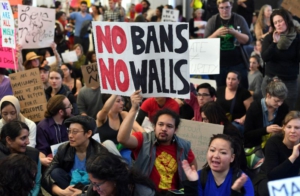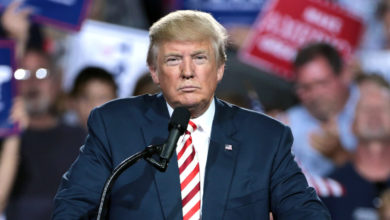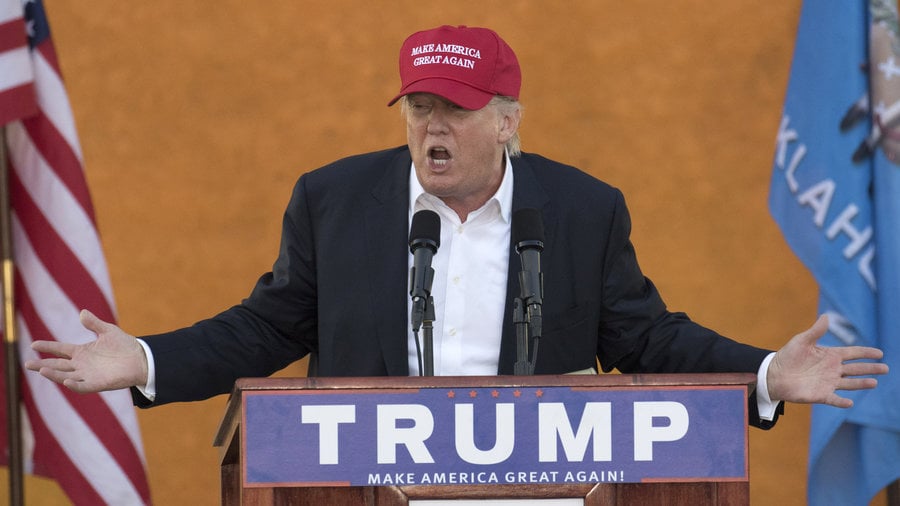 Feb. 9 marked the first major victory of the people’s movement against the Trump Administration, as his infamous travel ban was lifted. The major media outlets have reported almost exclusively on the legal side of the fight, marking the beginning and end in the government itself. Contrary to this House of Cards-esque narrative, the end of the travel ban is a true victory of the movement for human rights and dignity—a testament to the power of mass action.
Feb. 9 marked the first major victory of the people’s movement against the Trump Administration, as his infamous travel ban was lifted. The major media outlets have reported almost exclusively on the legal side of the fight, marking the beginning and end in the government itself. Contrary to this House of Cards-esque narrative, the end of the travel ban is a true victory of the movement for human rights and dignity—a testament to the power of mass action.
To understand the real magnitude of this victory requires understanding its context.
From the very beginning of the Trump-era, mass protests have beleaguered the administration. Just hours after Trump was “elected,” mass marches and rallies spontaneously filled streets across the United States and even around the world. His inauguration day was in practice the “inauguration of the resistance,” as more people turned out to protest his inauguration than to celebrate it. This is an unprecedented situation in U.S. history: not only did Trump assume power with his opposition vastly outnumbering his supporters, that opposition mobilized many more on a traditional day, bordering on semi-sacred, for the ruling class and its supporters. Equally unprecedented was the mass nationwide mobilization of the opposition in virtually every major city in the United States.
For its part, the Trump regime wasted no time moving to enact its ugly program of deportations, attacks on government workers, Islamophobia, enhancing police terror, a foreign policy built around arrogance and bullying, attacks on women and more. Those who predicted that Trump was “all talk” proved completely wrong as Trump moved to enact his campaign promises with shocking haste. Moreover, Trump’s cabinet picks promise to hold and maintain the course with eagerness and enthusiasm.
Together, these were the primary, if opposing, trends which were the backdrop for the developments over the travel ban and its fate. The travel ban was a critical part of Trump’s campaign, as he repeated time and again that he would seek “extreme vetting” and other draconian measures for immigrants seeking entry into the United States—really a euphemism for shutting the door as far as he could push it. Because it was so well understood by the time Trump took office, the executive order which put it into effect read to many as a nightmare come true, separating families, leaving some who had started lives in the United States stranded abroad, and leaving still others in limbo as they sought refugee status in the United States, even though the normal process” for gaining refugee status is extremely difficult and lengthy.
Just as when Trump unexpectedly clinched his victory last November led to flash mobilizations against him, people were in the streets almost immediately when Trump unrolled his long-awaited ban on Muslim immigrants. Within days, many major airports were shut down by protests.
The recent protests, however, bore all the markings of a blossoming resistance movement. Many who have never before engaged in any kind of protest are now coming out time and again for militant actions shutting down streets and making themselves heard. People are joining organizations, knowing it is the only way to sustain the movement. Perhaps most importantly, those who are in the streets, walking out of schools, going on strike and even shutting down airports, now unequivocally hold the moral high ground in the eyes of the public.
In other words, the massive manifestations of outrage and disgust that followed the ban when it became realized, were what stood out, not the almost-immediate challenge to the ban in the courts, the stay, or its eventual overturn in the 9th Circuit Court.
In fact, it follows the contours of many mass movements which forced court action to check overzealous repression by the ruling class. As a rule, the courts are not friends of poor, working and oppressed people, since they enforce laws which fundamentally repress our rights. Rather, the courts occasionally establish more lenient rulings on the basis that the law as previously enforced or as written is untenable for the ruling class’ continued grasp on power. For example, the Brown v Board of Education decision came after decades of struggle against Jim Crow, notably with Black people even taking up arms against both the Klan and the cops (often times indistinguishable entities in the Jim Crow South). The courts’ responsiveness to public pressure also explains how the Supreme Court under Obama ruled both in favor of marriage equality as well as in favor of Hobby Lobby’s “right” to limit its female employees’ right to contraception coverage by health insurance. The court’s implicit ruling was that it could get away with misogyny while it could no longer maintain the status quo as regards to anti-LGBTQ bigotry.
Rather than neutral protectors, the courts consequently sometimes act as final check on the ruling class’ own hubris. They are not the arbitrators who determine the application of higher moral standards, nor are they the kind of impartial, non-political forums enshrined in civics textbooks. The courts are organs of the state whose function is to interpret and apply the laws written first by slave owners and now by billionaires and the crooks who serve them; they do not stand above or separate from politics or society.
If the demise of this iteration of the Muslim ban spells a huge victory for the people’s movement, then the corporate media’s coverage attributing the victory to the courts is outright theft. Many liberal outlets are lionizing the judges of who “defiantly” stood opposed to the ban, while the reactionary outlets are blasting the judges as “disloyal,” as “traitors” or as “soft on terrorism.” Where those outlets agree is in denying the mass movement its place in overturning the ban. None dare to acknowledge the earthquake shaking the floors beneath them.
What it signifies about the Trump regime
The victory is instructive in many ways. It confirms that the only real defense poor, working and oppressed people have against the virulent bigotry and repression from Washington is resistance. It reveals the character of the courts and their relationship to the mass movement. It also shows the lines of division in the ruling class.
For the courts to act as an emergency brake for capitalist politics, there must be some contradiction within the ruling class, some dividing line separating those in favor of the status quo and those who favor a modification to it. Those lines were clear, for example, when Plessy v. Ferguson deemed segregation and Jim Crow legal. The remnants of the Radical and abolitionist Republican Party had lost out to the Republican Party’s burgeoning right wing and to the Southern Democrats. Brown v. Board was one of the ruling class’ first concessions to the civil rights movement and was one of the first steps which forced formerly “legitimate” mainline segregationists to either adopt coded language or to be forced out of high public office altogether.
Significant court actions such as these highlight major divisions within the ruling class—a fact which Trump’s advisors were no doubt aware of. The shakeup in the State Department, which left almost no high-level overlap from the Obama administration, and the fact that the Department of Homeland Security kept enforcing the ban despite court orders to the contrary, both speak to the executive orders’ effect as a loyalty test to the Trump administration.
What results is a Trump administration which is well aware of its strengths and weaknesses, its friends and enemies and of the roadblocks potentially ahead for its shamelessly bigoted and rapacious agenda. This development heightens the importance of mass struggle, as the forces most aggressively pushing bigotry, oppression and theft solidify their position. Moreover, Democrats have revealed in this critical time their craven willingness to do whatever possible to maintain some semblance of respectability while groveling to the Republican Party. Elizabeth Warren’s vote to confirm Ben Carson as head of Secretary of Housing and Urban Development is an outstanding example of the Democrats’ cowardice.
Put plainly, the Muslim ban’s demise shows the absolute need for struggle and self-reliance. Only struggle—shutting down streets and airports—made ending the Muslim ban possible. It was an initiative by the people themselves, not by liberals in Washington. The victory over the travel ban shows that struggle without self-reliant, popular leadership is anemic, but the goals and needs of the people will never be met without struggle.





